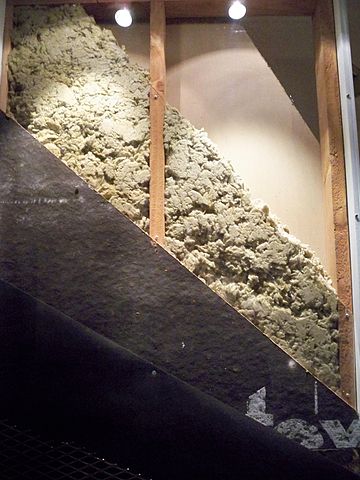
How does insulation in the home work? By slowing down the movement of heat energy out of the house or into the house.
The idea of insulation is to stop your house getting cold in the winter or hot in the summer. If you live somewhere that is cold in winter, you have to use some method to heat your house because humans need a certain temperature to live, or they could develop hypothermia. Likewise, if you live somewhere that is hot in summer, you will have to use some method to cool your house because humans need a certain temperature to live, or they could develop hyperthermia. If your house is badly insulated, a lot of the heat, or the cool air, will be lost to the atmosphere. Roughly 25% will go through the roof, 35% through the walls and gaps around the windows and doors, and 10% will go through the floor. That means you have to spend more to heat the house, because you are also heating the atmosphere. Having a house that is badly insulated is bad for your budget, but it is also bad for the environment because we need to find that power somewhere, and still, these days, most electricity comes from fossil fuels.
So, how does insulation in the home work? Heat moves around based on the second law of thermodynamics. That is, heat will always move from a hotter object to a colder object until they both have the same amount of heat and are balanced. The universe really doesn’t like having more energy in one place than in another and would be much happier if everything was the same. For example, if you put a cup of hot coffee on your kitchen table, the coffee is hotter than the air around it and the heat energy from the coffee will move to the air until the coffee is the same temperature as the air and the heat transfer will stop. If you put a glass of ice-cold Coca Cola on your kitchen table, the reverse will happen. The air will have more heat energy than the cold drink and heat will transfer from the air to the drink until the drink has warmed up to the same temperature as the air and the transfer will stop. This is basically entropy in a system and is probably what will happen at the end of the universe.
Your house works in the same way. When you heat the house, you are feeling it with heat energy. This heat energy desperately wants to get into the cold air around the house so that it is balanced. When you cool your house, you are taking out the heat energy by using the coolant in your air conditioner. The heat energy in the air around the house desperately wants to come in and balance out the temperatures. Home insulation works by stopping this transfer of heat as much as possible.
There are three ways heat energy can move around. These are conduction, convection, and radiation. Conduction is the process of heat moving through a solid object because the heat energy is transferred from molecule to molecule. If burn yourself by touching the outside of an oven door, that is conduction. Convection is the way that heat moves through a gas or a liquid. Incidentally, air is a gas that behaves like a liquid. When molecules gain heat energy from the heater in your house, they move and spread out more, which makes them less dense, and they rise. As they get higher, they lose their height through the roof and the walls, and they become more dense so they sink. When they are back at the bottom, they are heated, and the cycle begins again. Radiation is the way that energy travels in electromagnetic waves.
Housing insulation looks to slow down conduction and convection, and reflect radiation. There is no way to completely stop heat transfer and the best that can be hoped for is to slow it down as much as possible. The goal is to put a material in the walls and ceilings of the house that can slow down the conduction of heat. This is usually done with fiberglass or cellulose. They are fibrous materials that have a lot of pockets that trap the air, slowing down the conduction of the heat energy. The more material you have, the more heat it will trap. These are natural materials and have open pockets for the air to move into. Some synthetic materials have closed cells, which trap the air, but they don’t allow the house to breathe and can be a problem for condensation and mold. Thermal insulation on the ceilings prevents convection as well. The less dense air wants to rise into the upper parts of the house, and then out through the roof. The insulation in the ceilings tries to keep the heat circulating in one room, or cell as it is called. And insulation on the walls and floor of the attic, or ceiling if you don’t have an attic, attempts to reflect away electromagnetic waves that are coming from the sun, thereby keeping the house cooler.
Different materials are better or worse at slowing down heat transfer and they are rated with an R and a U value. The R-value is how well the material resists heat transfer and a higher number is better. The U-value is how quickly heat travels through a material and a lower number is better. 9 cm of fiberglass has an R-value of about 11. 9 cm of cellulose has an R-value of 12, and 9 cm of closed cell spray foam has an R-value of 22. Different materials have vastly different insulating properties. And this is what I learned today.
Image By ‘Matthew G. Bisanz, CC BY-SA 3.0, https://commons.wikimedia.org/w/index.php?curid=7977520
Sources
https://www.energy.gov/energysaver/insulation
https://www.eco-home-essentials.co.uk/how-insulation-works.html
https://en.wikipedia.org/wiki/Second_law_of_thermodynamics
https://www.buildingmaterials.co.uk/info-hub/insulation/how-does-insulation-work
https://www.everguardinsulation.com/how-insulation-works/
https://www.kingspan.com/gb/en/knowledge-articles/what-are-u-values-r-values-and-lambda-values/
